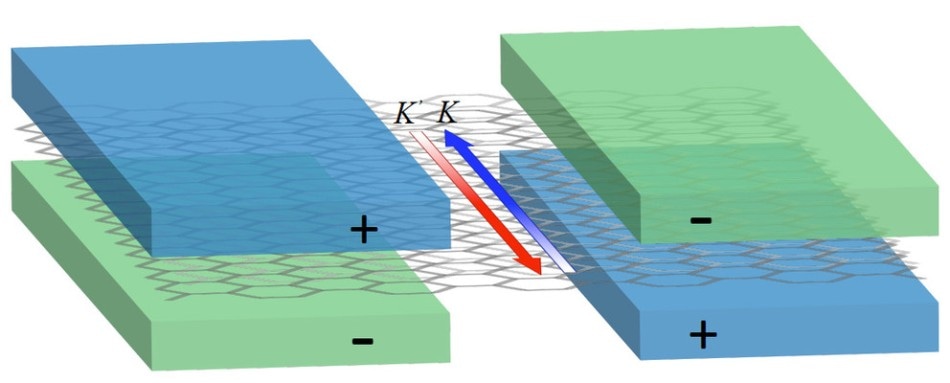Aug 30 2016
 graphene gated by two pairs of split gates above and below the sheet. Wires traveling in opposite directions carry electrons of different valley states labeled as K and K’ in the figure. Fig.C: A scanned electron micrograph of a device used in this experiment. Thin sheets of graphene and hexagonal Boron Nitride are stacked and shaped by electron beam lithography to create this device. The purple layer is the bilayer graphene sheet. The bottom pair of split gates (dark squares) are made of multi-layer graphene. The top pair of split gates (gold bars) are made of gold. The one-dimensional wires live in the gap created by the split gates. Credit: Image: Jun Zhu / Penn State
graphene gated by two pairs of split gates above and below the sheet. Wires traveling in opposite directions carry electrons of different valley states labeled as K and K’ in the figure. Fig.C: A scanned electron micrograph of a device used in this experiment. Thin sheets of graphene and hexagonal Boron Nitride are stacked and shaped by electron beam lithography to create this device. The purple layer is the bilayer graphene sheet. The bottom pair of split gates (dark squares) are made of multi-layer graphene. The top pair of split gates (gold bars) are made of gold. The one-dimensional wires live in the gap created by the split gates. Credit: Image: Jun Zhu / Penn State
A recent breakthrough in a new field of physics known as valleytronics is the development of a device made of bilayer graphene.
This new device, which is an atomically thin hexagonal arrangement of carbon atoms, offers experimental proof of the capability to monitor the momentum of electrons. It also has potential for electronics that may need less energy and generate less heat than conventional silicon-based transistors.
Current silicon-based transistor devices rely on the charge of electrons to turn the device on or off, but many labs are looking at new ways to manipulate electrons based on other variables, called degrees of freedom. Charge is one degree of freedom. Electron spin is another, and the ability to build transistors based on spin, called spintronics, is still in the development stage. A third electronic degree of freedom is the valley state of electrons, which is based on their energy in relation to their momentum.
Jun Zhu, Associate Professor of Physics, Penn State
Zhu suggested that imagining the electrons as cars and the valley states as red and blue colors will help to differentiate them from each another. Electrons, when present inside a bilayer graphene sheet, generally occupy both the blue and red valley states and move in all directions.
Zhu’s Ph.D. student, Jing Li, has been working on a device capable of making the red cars go in a specific direction and the blue cars in the opposite direction.
"The system that Jing created puts a pair of gates above and below a bilayer graphene sheet. Then he adds an electric field perpendicular to the plane," Zhu said.
By applying a positive voltage on one side and a negative voltage on the other, a bandgap opens in bilayer graphene, which it doesn't normally have. In the middle, between the two sides, we leave a physical gap of about 70 nanometers.
Jing Li, Ph.D. Student, Penn State
One-dimensional metallic states, or wires exist in this gap, and they are color-coded freeways for electrons. The blue and read cars travel in opposite directions, respectively.
In theory, the colored electrons are capable of traveling through the wires without any disturbance for a long distance and with very low resistance. The smaller resistance highlights reduced power consumption in electronic devices and less heat generation. Challenges faced by the existing miniaturized devices include both thermal management and power consumption.
"Our experiments show that the metallic wires can be created," Li said. "Although we are still a long way from applications."
It's quite remarkable that such states can be created in the interior of an insulating bilayer graphene sheet, using just a few gates. They are not yet resistance-free, and we are doing more experiments to understand where resistance might come from. We are also trying to build valves that control the electron flow based on the color of the electrons. That's a new concept of electronics called valleytronics.
Jun Zhu, Associate Professor of Physics, Penn State
Li worked in close association with the technical staff of Penn State's nanofabrication facility in order to convert the theoretical framework into a working device.
"The alignment of the top and bottom gates was crucial and not a trivial challenge," said Chad Eichfeld, nanolithography engineer. "The state-of-the-art electron beam lithography capabilities at the Penn StateNanofabrication Laboratory allowed Jing to create this novel device with nanoscale features."
Their paper, "Gate-controlled topological conducting channels in bilayer graphene," appears in the recent online version of the journal Nature Nanotechnology. Additional authors include Ke Wang and Yafei Ren and their advisor Zenhua Qiao of University of Science and Technology of China, who varied out a number of studies to model the behavior of the wires. The superior quality hexagonal Boron Nitride crystals used in the experiment came from Kenji Watanabe and Takashi Taniguchi of National Institute for Material Science, Japan. Two undergraduate students, Zachary Zern and Kenton McFaul, contributed to the study.
The research was funded by the National Science Foundation, the U.S. Office of Naval Research, and funding agencies in Japan and China. Kenton McFaul, a visiting student from Grove City College, was supported by a Research Experience for Undergraduates grant from the NSF NNIN. Jun Zhu is a member of the Center for 2-Dimensional and Layered Materials in Penn State's Materials Research Institute.